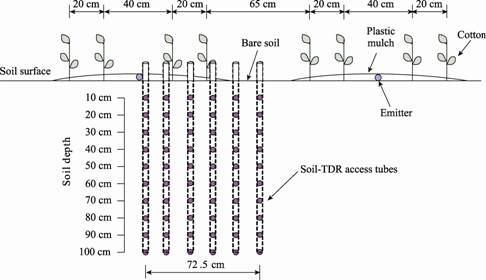Effects of Emitter Discharge Rates on Soil Salinity Distribution and Cotton Yield under Drip Irrigation with Plastic Mulch
2013-03-27
Water shortage and soil salinization are two key problems that limit the development of agriculture in arid regions. At present, soil salinization has already become a global environmental hazard and ecological concern. China is one of the biggest soil salinization countries in the world. Xinjiang, a typical arid region located in the northwestern part of China, has a soil salinization area of 0.2 million km2, accounting for 22% of the total salinized area in China. The most of the salinized area is located in the Tarim River catchment in South Xinjiang.
Under-film drip irrigation technique has been introduced into Xinjiang and is beneficial to enhance crop yield and utilization of water. When drip irrigation is applied in saline soils, it is crucial to develop a proper irrigation schedule that meets both crop water requirement and leaching requirement for salts added in irrigation water within the root zone.
Therefore, DANIERHAN Sulitan et al. conducted a field experiment to investigate the effects of different drip irrigation regimes on soil salinity distribution and cotton yield in an arid region of Tarim River catchment.
Four treatments of emitter discharge rates, i.e. 1.8, 2.2, 2.6 and 3.2 L/h, were designed under drip irrigation with plastic mulch in this study. The salt distribution in the range of 70-cm horizontal distance and 100-cm vertical distance from the emitter was measured and analyzed during the cotton growing season. The soil salinity was measured using Time Domain Reflector (TDR) 20 times a year, including 5 irrigation events and 4 measured times before/after an irrigation event. The groundwater depth was observed by SEBA MDS Dipper 3 automatically at three experimental sites.
The results showed that the order of reduction in averaged soil salinity was 2.6 L/h > 2.2 L/h > 1.8 L/h > 3.2 L/h after the completion of irrigation for the 3-year cotton growing season. Therefore, the choice of emitter discharge rate is considerably important in arid silt loam. Usually, the ideal emitter discharge rate is 2.4–3.0 L/h for soil desalinization with plastic mulch, which is advisable mainly because of the favorable salt leaching of silt loam and the climatic conditions in the studied arid area. Maximum cotton yield was achieved at the emitter discharge rate of 2.6 L/h under drip irrigation with plastic mulch in silty soil at the study site.
So, the emitter discharge rate of 2.6 L/h is recommended for drip irrigation with plastic mulch applied in silty soil in arid regions. The result was published in Journal of Arid Landin March 2013, 5(1): 51-59.

The cultivation pattern of cotton and the position of Time Domain Reflection (TDR) access tubes (Image by XIEG)



